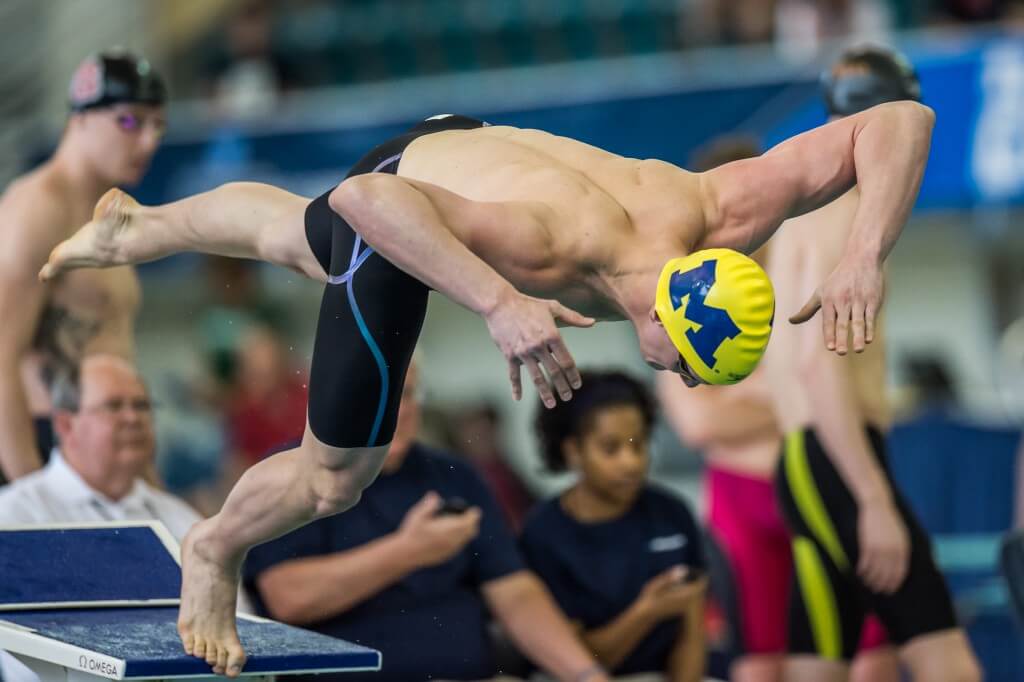Boys to Men

NCAA DI Championship Editorial Coverage is proudly sponsored by Adidas. Visit All-American Swim for more information on our sponsor. For all the latest coverage, check out our event coverage page.
By Michael J. Stott
On display at the McAuley Aquatic Center this week are obvious physical disparities. For instance, a 6’9” Texas Longhorn Clark Smith towers over Tennessee’s 1-meter champion Liam Stone, but there is also an emotional divide, often defined, but not always, by an age differential. We have seniors readying for graduation while freshmen and others still are adjusting to college from the life as a high school or club swimmers.
How that adjustment is made is a shared task between athlete and coach.
“As youngsters come in parents have worked real hard to mold them to the person they are,” says University of Georgia senior associate coach Harvey Humphries. “At college, they are away from parents, don’t get feedback on what’s right and wrong and are required to be not only low maintenance but make decisions on their own. The first step in maturing is learning to take care of themselves. As an athlete they learn what they need for training, how to warm up, warm down and how to communicate with coaches.”
“They also learn how to be part of a team. We want to learn about them, what they have to say. We can’t coach them if we can’t listen to them. We might not agree with one another but we need to be on the same page when the deal is on,” says Humphries.
“In the maturation process a question becomes ‘are they a support giver?’ As they get confidence, they can concentrate on making teammates better. If they can take care of themselves out of the pool and in the classroom that allows them to help teammates and make everyone around them better. You don’t have to be the fastest guy on the team or even a point scorer but if you can make 10 other people better you might be the most valuable guy there,” he says.
“A perfect example would be the Litherland brothers.
“They work as a unit to a certain extent,” says Humphries.
These sophomore triplets matriculated to Georgia after claiming seven high school state championships as seniors. This year they all qualified for the NCAA meet with Jay and Kevin already earning All-American honors.
“They will give you a great effort no matter what. They never leave the pool without saying ‘thank you’ and in the heat of battle never disrespect a teammate or coach. They have a great ability to control emotions and get ready for what comes next.”
Humphries was a coach on the World University Games squad this year and happily tells of Jay Litherland’s contributions. Jay swam one event, the 400 meter IM. It came on the 11th and last day of the meet. Throughout the team’s stay Litherland was a consummate presence buoying swimmers. He had a poor prelims swim and in finals when trailing with 100 meters to go rallied to win.
“Because he did his job as a teammate for 11 days you couldn’t have seen a team happier for a guy,” says Humphries.
At 6’5’ Michigan’s Paul Powers played defensive end and center on his high school basketball team before being talked into swimming full time as a senior. A Gainesville, Ga., product, Powers came to the attention of Sabir Mohammed who recognized his promise and began working with him initially in eighth grade. A sprinter by inclination and training Powers became two-time National Junior Team and World Junior team member winning three golds at the 2014 Junior Pan Pac meet in Hawaii.
As Paul began exploring recruiting options his father Randall called SwimMAC’s David Marsh who suggested Mike Bottom at Michigan might be a good fit for his independent, enthusiastic, character-driven son. A conversation that Paul had with Anthony Ervin, also an independent soul, strengthened the notion that Bottom was a good fit.
Freshman year was a struggle physically and emotionally. At 215 pounds Powers could bench press 450 pounds. Upon arriving in Ann Arbor, his maximum practice yardage had been 3000 yards. The acclimation to the greater volume demands took its toll.
“He is highly self-reliant and motivated and the first year was a struggle emotionally and physically,” says his father. “The academics drove him to physical exhaustion and impacted his swimming. His times did not improve. The weather in Michigan was cold. Yet through it all Powers earned three All-American honors.
Fast forward to 2016. He still has good strength to weight ratio and is down to 204 pounds.
“The character development with Mike Bottom has been amazing,” says Randall. “When you drop your 17-18-year-old off at a university you wonder who are you leaving him with. Mike Bottom has been a great fit for Paul’s personality. He is not a naturally gifted swimmer and Mike is working with him on his stroke This year Paul is a different man. He’s happy. He’s adjusted to the school environment,” says his dad. He is also a six-time Big Ten champion (and record holder in the 50 free at 18.85). Already this week he has earned two more All-American honors with opportunities for more.
“The progression with Paul continues,” says Randall.
In swimming coaches often talk about “the process and the journey.”
For the young men above epitomize that sojourn from boys to men.
“The athlete has to know that his value has nothing to do with performance, but with commitment, dedication and the ability to do things right,” says Humphries. “That’s what gives them the respect and trust of the coaches.”




.png)